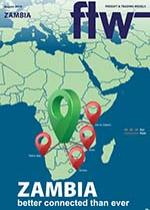Namibia has added a new deep-water port to the global gateways open to shippers and cargo owners moving freight between the rest of the world and the Copperbelt. Exporters and importers based in Zambia and the Democratic Republic of Congo (DRC) can now choose between Dar es Salaam, Beira, Durban and Walvis Bay. There are strong logistics chains linking the first three, and a partnership between the Namibian government and private operators is making it easier and more cost-effective to use Walvis Bay’s new container terminal and soon-to-be refurbished bulk and breakbulk terminals. Zambia has a stake in the harbour in the form of a dry port, which provides shippers with duty-free storage and transhipment inside the port precinct. With the port’s new container terminal operational, the Namibian government is focusing on road and rail infrastructure to link the port more closely to the hinterland, which Namibia sees as all the neighbouring countries, including southern DRC. Priority road projects include the tarring of a link road “behind the dunes” between Walvis Bay and Swakopmund. It will take pressure off the existing congested road bordering on the Atlantic Ocean, and should be less affected by the region’s fogs. There are around six road upgrades either under construction or planned for the Walvis Bay corridors. Modernisation of the Namibian Railway network has commenced with the upgrade of the Walvis Bay to Tsumeb section of the line. New rails for the line were being offloaded when FTW was in the port of Walvis Bay recently for the official inauguration of the new container terminal. There are plans to extend the rail to the borders of Zambia and Botswana to link up with new lines on the other side of the borders. Private sector investment includes the building of new warehouses and cold stores in Walvis Bay, and entry into the market by new transport companies. They are challenging the status quo and driving down rates on the corridor, making it more competitive. Driving the competitiveness of Walvis Bay as a Zambia/ DRC gateway is the Walvis BayNdola-Lubumbashi Development Corridor Group, which is responsible for coordinating the development and marketing of the route. None of the other three corridors are being steered by a similar dedicated organisation, which is part of the Walvis Bay Corridor Group. “WBCG remains close to these developments and continues to advocate for priority transport infrastructure that is supported by a robust supply chain network, conducive policies and regulations, and a core focus on trade facilitation to ease the movement of goods and people,” says the group’s acting chief executive officer Clive Smith.
INSERT with IMAGE
WBCG continues to advocate for priority transport infrastructure that is supported by a robust supply chain network. – Clive Smith

